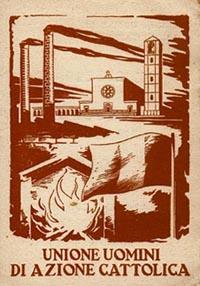Clerical fascism is an ideology that combines the political and economic doctrines of fascism with clericalism. The term has been used to describe organizations and movements that combine religious elements with fascism, receive support from religious organizations which espouse sympathy for fascism, or fascist regimes in which clergy play a leading role.

Vittorino Veronese was an Italian anti-fascist lawyer and activist who served as UNESCO’s Director-General from 1958 to 1961. Before his appointment as UNESCO’s Director-General he served as Chairman of the Catholic Institute for Social Activity and of Azione Cattolica. From 1952 to 1956 he served on UNESCO’s board and was UNESCO’s chairperson from 1956 to 1958. Three years after the appointment as the Director-General, Veronese had to resign due to health concerns.

Luigi Sturzo was an Italian Catholic priest and prominent politician. He was known in his lifetime as a Christian socialist and is considered one of the fathers of the Christian democratic platform. He was also the founder of the Luigi Sturzo Institute in 1951. Sturzo was one of the founders of the Italian People's Party (PPI) in 1919 but was forced into exile in 1924 with the rise of Italian fascism, and later in 1943 Christian Democracy, although he was never a party member. In exile in London and later New York City, he published over 400 articles critical of fascism. Sturzo's cause for canonization opened on 23 March 2002 and he is titled as a Servant of God.
Neo-Guelphism was a 19th-century Italian political movement, started by Vincenzo Gioberti, which wanted to unite Italy into a single kingdom with the Pope as its king. Despite little popular support, the movement raised interests among intellectuals, journalists and Catholic reformist politicians. They were also linked both to ontologism, a philosophical movement, and to rationalist-leaning theology.

The Italian Catholic Church, or Catholic Church in Italy, is part of the worldwide Catholic Church in communion with the Pope in Rome, under the Conference of Italian Bishops. The pope serves also as Primate of Italy and Bishop of Rome. In addition to the Italian Republic, two other sovereign states are included in Italian dioceses: San Marino and Vatican City. There are 225 dioceses in the Catholic Church in Italy, see further in this article and in the article List of Catholic dioceses in Italy.
Catholic Action are groups of lay Catholics who advocate for increased Catholic influence on society. They were especially active in the nineteenth century in historically Catholic countries under anti-clerical regimes such as Spain, Italy, Bavaria, France, and Belgium.

Giuseppe Spataro was an Italian politician.

La Civiltà Cattolica is a periodical published by the Jesuits in Rome, Italy. It has been published continuously since 1850 and is among the oldest of Catholic Italian periodicals. All of the journal's articles are the collective responsibility of the entire "college" of the magazine's writers even if published under a single author's name. It is the only one to be directly revised by the Secretariat of State of the Holy See and to receive its approval before being published.

The Italian People's Party, also translated as Italian Popular Party, was a Christian-democratic political party in Italy inspired by Catholic social teaching. It was active in the 1920s, but fell apart because it was deeply split between the pro- and anti-fascist elements. Its platform called for an elective Senate, proportional representation, corporatism, agrarian reform, women's suffrage, political decentralisation, independence of the Catholic Church, and social legislation.
Pietro Tacchi Venturi was a Jesuit priest and historian who served as the unofficial liaison between Benito Mussolini, the Fascist leader of Italy from 1922 to 1943, and Popes Pius XI and Pius XII. He was also one of the architects of the 1929 Lateran Treaty, which ended the "Roman Question", and recognized the sovereignty of Vatican City, which made it an actor of international relations. A claimed attempt to assassinate Venturi with a paper knife, one year before the treaty's completion, made headlines around the world. Venturi had begun the process of reconciliation by convincing Mussolini to donate the valuable library of the Palazzo Chigi to the Vatican.

Romolo Murri was an Italian politician and ecclesiastic. This Catholic priest was suspended for having joined the party Lega Democratica Nazionale and is widely considered in Italy as the precursor of Christian democracy.
The Italian Catholic Federation of University Students is a federation of groups representing Roman Catholic university students in Italy.
The Italian Catholic Electoral Union was a political organization designed to coordinate the participation of Catholic voices in Italian electoral contests. Its founder and leader was the Count Vincenzo Ottorino Gentiloni.
UCSC Student Associations are students' group of Università Cattolica del Sacro Cuore. They organize cultural and social activities among the students of the university. Some associations are linked to Italian political parties, others are nonpartisan.

Primo Mazzolari, best known as don Primo, was an Italian priest of the Catholic Church. He was also a partisan and writer who established the review Adesso ("Now") in 1949.
Action is a liberal political party in Italy. Its leader is Carlo Calenda, a member of the European Parliament within the group of Renew Europe and former minister of Economic Development.
Events in the year 1931 in Vatican City.









